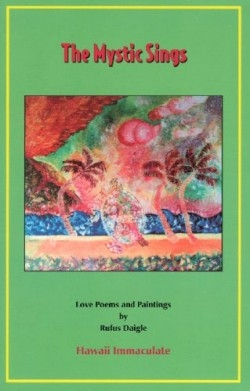The Mystic Sings
Poetry and art join together in Rufus Daigle’s The Mystic Sings to create a unique and pleasurable book. Many of the poems in the book appear to be untitled, yet the beginning of each poem is clearly indicated by a small sketch by the author. These poems may be untitled because they are nothing less than pure expressions that originate from moments of deep and personal inspiration. The untitled poems can be compared to the sketches that preface them, because a visual artist will often create a small, yet brilliant work of art when the muse strikes — on any available material such as a napkin, a piece of stationery, or a page of notebook paper. There are also poems with titles, and these pieces appear to be more deliberate and planned, but equally as inspired. The titled poems could possibly be compared to the full-color paintings by the author displayed throughout the book, because each large painting is titled as well. Each sketch, poem, and painting by Daigle is an exquisite and thought-provoking work of art.
His poems are creations that convey the emotion of love in beautiful language. The love expressed takes on both a spiritual and a temporal form. Daigle is a mystic who asserts that many of the poems were inspired by a goddess. He is also a graduate of Southern Methodist University in Dallas, Texas, as well as a veteran and former P.O.W. of the Vietnam War. Daigle seems to draw upon his moral inclinations and earthly events in order to offer the reader something far outside of ugliness, cruelty, or war. One of his untitled poems illustrates the splendor with which he writes about physical love: “If you were in / my arms / You would be sun feasts / gladiolas / resting vertical / Calling the cries of virgins / In green vales of / sweat. A titled and more spiritual poem in the book, “Immortal Beloved,” demonstrates Daigle’s ability to craft metaphors that are exclusive to his style as this excerpt reveals: “The lilac that swims / with race thoughts / pine / Furloughs minions / of flawless ballet.
The full-color paintings in the book could periodically be described as reminiscent of Picasso’s blue period. With titles such as, “Portrait of Popolo Girl” and “Goddess 1st,” they depict feminine beauty in both divine and physical form. Other large paintings in the book are completely abstract such as “Portrait of My Silence.” The small sketches in the book range from detailed to vague. A few of the sketches might be compared to the style of Salvador Dali.
Since this book is both love poetry and artwork, it will appeal to those who have great appreciation for either. It will also be of great interest to readers who value books of a spiritual nature. Whatever the initial attraction is, the reader will enter a world where love is held above all else and is beautifully expressed.
Reviewed by
Brian Douthit
Disclosure: This article is not an endorsement, but a review. The publisher of this book provided free copies of the book and paid a small fee to have their book reviewed by a professional reviewer. Foreword Reviews and Clarion Reviews make no guarantee that the publisher will receive a positive review. Foreword Magazine, Inc. is disclosing this in accordance with the Federal Trade Commission’s 16 CFR, Part 255.

